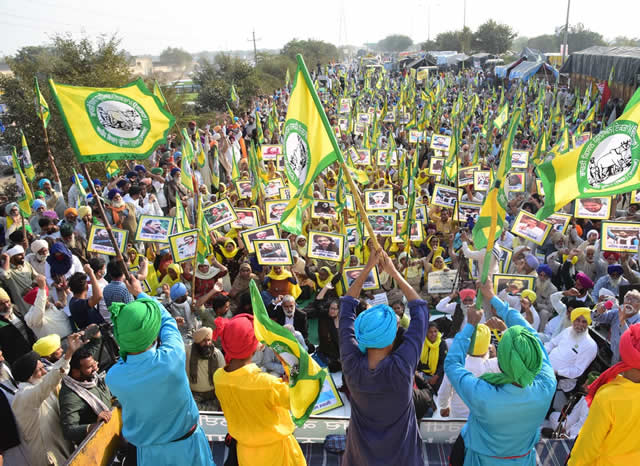
INDIA - Angry Farmers Block Highways
Singh and five other farmers from his village in the western state of Punjab have been living on their own supplies, including a gas cylinder and raw produce they packed from their farms when they drove down in a tractor to join thousands more in a mounting campaign to pressure the government to raise crop prices.
While the specific factors fueling the anger vary from country to country, the result is largely the same: Farmers say governments need to take drastic action if their way of life is to survive. And the timing is no coincidence, experts say, with protesters seeking favorable policies in a year with a record number of elections around the globe.
Almost two-thirds of India’s 1.4 billion population are farmers.
For decades they relied on a minimum support price for their crops, which is a rate at which the government guarantees to buy surplus stock at the end of the harvest.
But in 2020, the government opened up the markets to corporate buyers, who work directly with the farmers.
“It looked good on paper,” said Garrett Graddy-Lovelace, an associate professor at American University in Washington, D.C. But “the farmers knew that if they were dealing directly with the buyer, the buyers would drive the price down to nothing.”
Across the European Union, farmers say they are battling soaring costs of living and production, rising taxes and the burden of new environmental rules, which they say renders them uncompetitive against cheaper imports from abroad.
-www.nbcnews.com, 21 March 2024
Arno's Commentary
Food security is a much-needed government policy, but the income to sustain family farming operations depends on the prices of produce.
While two-thirds of the Indian population work in food production—representing almost 66%—in the European Union, agriculture employees register at below 2% of the population. Despite the dramatic difference in economic culture, European farmers are protesting as well. Quite apparently, “free market” is not the answer. Farmers in India do not have the skills, experience, and practical knowledge to go about determining prices for their produce; hence, they need the government to guarantee prices so farmers can continue operating.
This writer was a member of the West Australian Wheat Board in the 1960s. Regardless of the global price for wheat, income was guaranteed, and government would subsidize farmers. A Google search reveals that farms subsidies were $12.6 billion for 2023. The Cato Institute reports: “The U.S. Department of Agriculture runs dozens of farm subsidy programs, which cost taxpayers more than $30 billion a year.”
What happens when natural catastrophes occur? “Since 2017, Congress has passed ‘an astounding $60 billion in ad-hoc disaster assistance’ in a series of bills.”
Whenever the government spends money, it is tax money. Thus, we see that this type of socialism practiced globally actually seems to be quite effective. The USDA Economic Research Service reports that the agricultural share in the overall US economy stands at 5.5% (2022).
In summary, while there are pockets in some countries where food shortages occur, in general, global food production stands at record highs.
What is not mentioned is our dependence on the Creator. Deuteronomy 11:14 declares: “That I will give you the rain of your land in his due season, the first rain and the latter rain, that thou mayest gather in thy corn, and thy wine, and thine oil.”



